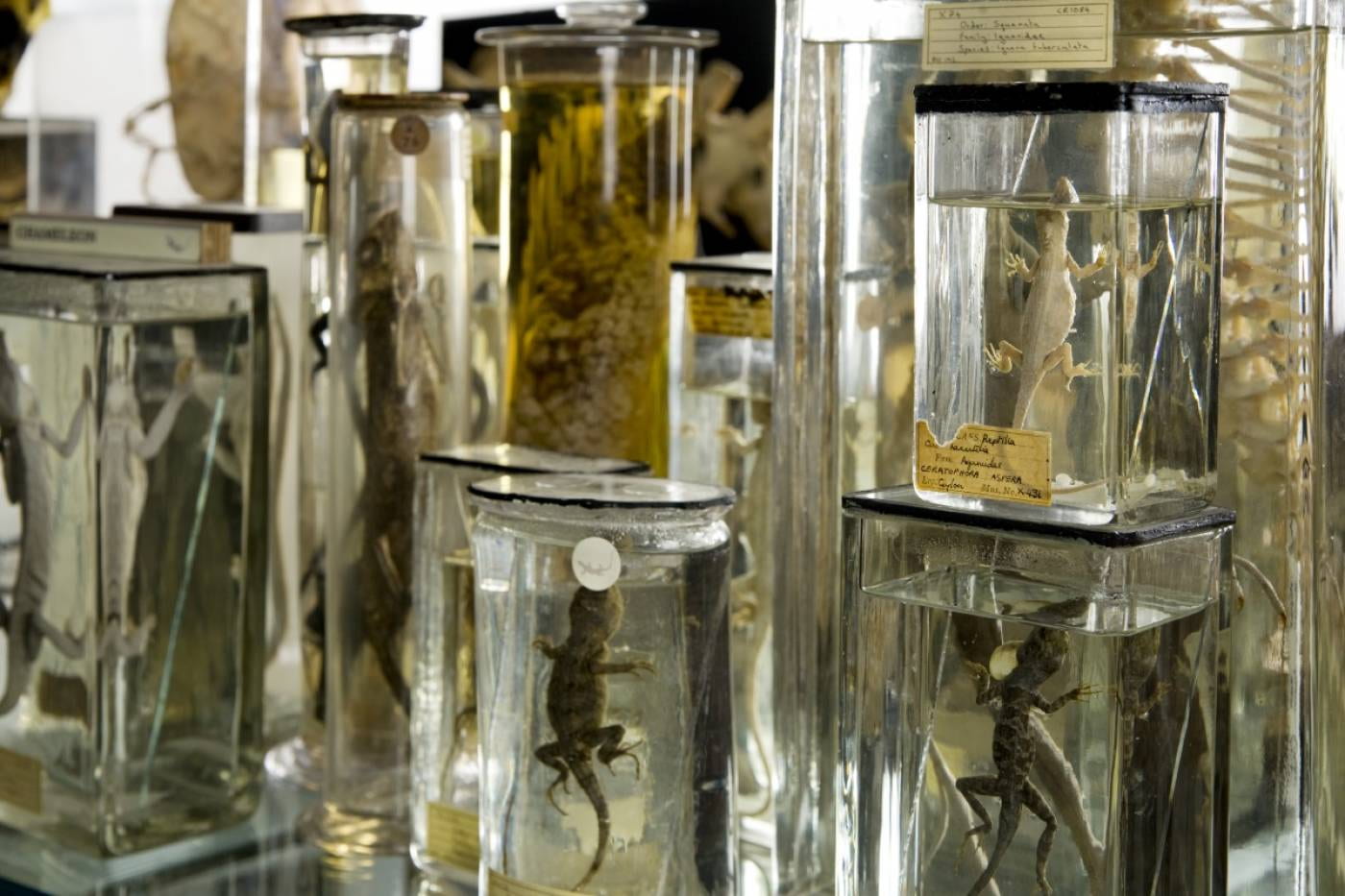Specimen of the Week 386: A Cocktail of Spirits: Fluid Preservation at the Grant Museum
By Katie Davenport-Mackey, on 19 July 2019
The Grant Museum contains a staggering number of specimens – the estimate is more than 68,000 – and approximately 10% are fluid preserved specimens. Fluid preservation describes specimens that are preserved in chemicals that protect them from deterioration. There are three components to a fluid preserved specimen:
- The fixed specimen: The specimen is injected or ‘fixed’ with a chemical that prevents decomposition by stabilising the protein molecules. The most common fixative is formaldehyde.
- The preservative fluid: Most fluid preserved specimens are preserved in solutions of alcohol or formalin, a mixture of formaldehyde and water.
- The container: Containers are typically glass jars or bottles sealed with a closure.
Below is a brief description of some of the different preservative fluids that can be found in the Grant Museum.
Alcohol
In museum collections it is common for zoology specimens to be preserved in ethanol (i.e. a type of alcohol) or industrial methylated spirit. An example in the Grant Museum that is preserved in industrial methylated spirit is arguably the museum’s most popular exhibit – the jar of moles (Z2754). We do not know precisely under what circumstances the moles came to be a part of the Grant Museum collection. It is possible they were intended for dissection by students of an anatomy class. Industrial methylated spirit is a mixture of 95% ethanol with 5% methanol. The purpose of adding a small amount of methanol is to make the alcohol unsuitable for human consumption.
Formalin
In museum collections it is common for zoology specimens to be preserved in a formaldehyde and water solution known as formalin. An example in the Grant Museum that is preserved a formalin solution is the Negus Collection of Bisected Heads. These heads were cut in half by Sir Victor Negus to show the larynx (i.e. the voice box) in a chimp, wallaby, sloth, seal, pangolin, domestic dog, lemur, wolf fish, calf, rabbit, and shrew. Formalin is a solution of 37% formaldehyde and 63% water. There is a common misconception that formaldehyde is a preservative fluid. However, formaldehyde is a gas at room temperature and the preservative fluid is actually a mixture of formaldehyde gas and water.
Kaiserling III
In museum collections it is rare of zoology specimens to be preserved in Kaiserling III. Historically, it is pathology specimens that have been preserved in this fluid. The one example in the Grant Museum that is preserved in Kaiserling III is the human brain (UCL.16.001) that has been borrowed from the UCL Pathology Museum. The human brain was acquired by the Grant Museum to complement its brain collection and show the differences between the human brain and those of other species. Kaiserling III is a solution of potassium acetate (i.e. the chemical that gives a vinegar taste to potato crisps), glycerine, and water. So next time you eat a packet of salt and vinegar crisps, spare a thought for the fluid preservation processes at the Grant Museum.
References
American Museum of Natural History. No date. Fluid Preserved Specimens. [Online]. [17 July 2019]. Available from: https://www.amnh.org/research/natural-science-collections-conservation/general-conservation/health-safety/fluid-preserved-specimens
National Park Service. 2001. Safe Storage and Handling of Natural History Specimens Preserved in Fluid. Conserve O Gram. 2(18), pp. 1-4.
Simmons, J.E (2014). Fluid Preservation: A Comprehensive Reference. Maryland: Rowman and Littlefield.
Katie Davenport-Mackey is a Museum Visitor Services Assistant at UCL Culture.
2 Responses to “Specimen of the Week 386: A Cocktail of Spirits: Fluid Preservation at the Grant Museum”
- 1
-
2
What liquid is used to preserve specimens? Explained by FAQGuide wrote on 4 October 2022:

[…] Source: https://blogs.ucl.ac.uk/museums/2019/07/19/specimen-of-the-week-a-cocktail-of-spirits-fluid-preserva… […]
 Close
Close






This is offensive and disrespectful. What scientific purpose does a jar of moles serve? Each one these animals was a living being, whose life was taken at a time when there was little respect for other species, and who were seen as resources for humans to abuse and exploit and have now become nothing to create a nothing more than curiosity for this ‘slightly quirky blog’.